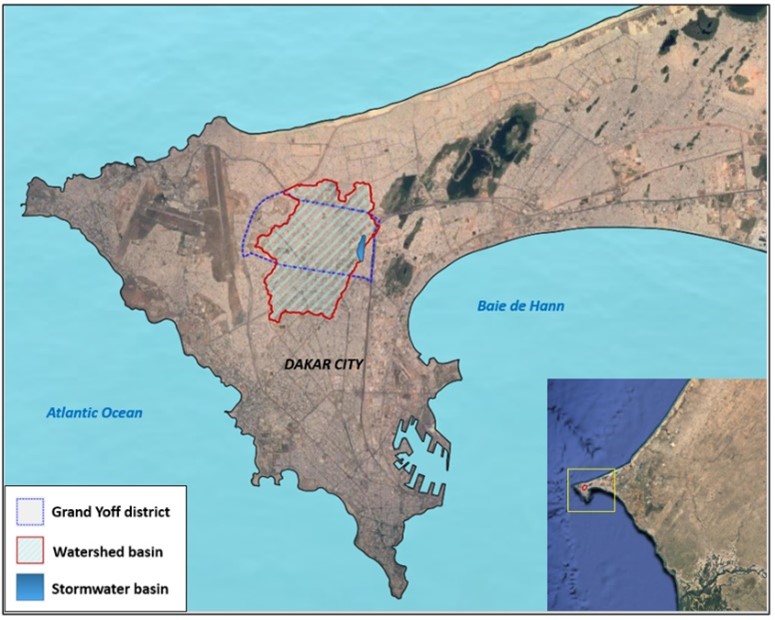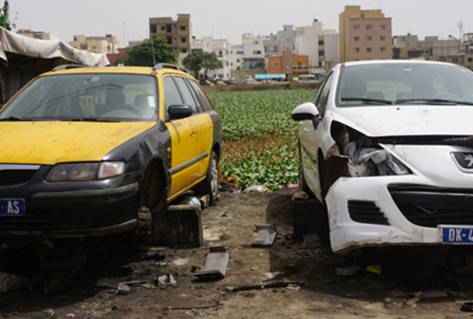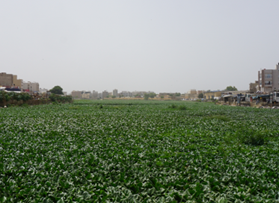Summary
Regular flooding of Dakar’s outlying districts poses a problem of extreme vulnerability for the city and will further worsen with increased rainfall frequency due to climate change. Due to this ongoing threat. The Grand Yoff storm-water retention basin (known as “Zone de Captage” is in one of the 19 districts of Dakar, and has issues of flooding, water quality and drainage. The area a natural marshland where rainwater runoff from the surrounding watershed is collected, and then infiltrates into the groundwater. The marshland was developed into a retention basin following severe flooding in 2006. However, rapid urbanisation, land use change, poor upstream management, sedimentation, aquatic weeds, unmanaged wastewater discharge and dumping of solid waste have degraded the area. This means that during heavy rains the retention basin overflows and floods the surrounding catchment area with contaminated water impacting health, the local economy, livelihoods and environment.
The City of Dakar in partnership with the Cities Finance Facility (CFF) are preparing a project to regenerate the retention basin so it meets the needs of the community and the city. Redevelopment aims to have integrated solutions that considers all urban aspects, from social to hydraulic, allowing the basin to reconnect to its environment and watershed. Flagship actions include redirecting wastewater to be treated with nature-based infrastructure on site; reshaping of the basin topography to enhance its hydraulic performance (volume) and allow water to flow freely out of the basin; and creation of a functional recreational space.
Problem:
- Flooding
- Wastewater discharge
- Waste disposal
- Public health issues
- Lack of public space and infrastructure
- Groundwater pollution
Solution:
- Redirect wastewater and treat residual wastewater on-site with nature-based infrastructure.
- Reshape the basin topography to enhance hydraulic performance (volume) and allow water to flow out of the basin area.
- Support seasonal use of the basin for community activities and recreation (e.g. sports grounds, urban market gardening or playgrounds).
1. The Problem
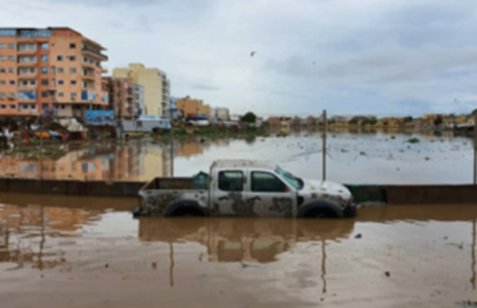

Regular flooding of Dakar’s outlying districts poses a problem of extreme vulnerability for the city and will further worsen with increased rainfall frequency due to climate change. Due to this ongoing threat, the government of Senegal has made flood control one of its priorities, which is reflected in the “Plan Emergent Sénégal” (Decennial Strategy Plan 2014-2023) and is being operationalized through the Ten-Year Flood Control Programme adopted in 2012.
The Grand Yoff storm-water retention basin (known as “Zone de Captage”) is in one of the 19 districts of Dakar and has issues of flooding water quality and drainage. The area is a historical marshland where rainwater run-off from the entire watershed collects and infiltrates the aquifer. In 2006, a major rain event caused extensive flooding in Dakar especially in the Grand Yoff area around the marshland and downstream towards Hann Bay. This event resulted in the development of the marshland area into a constructed retention basin (or pond) to capture rainwater from the Grand Yoff catchment area and limit the risk of flooding in event of heavy rain.
Since 2015, the natural function of the retention basin has been degraded due to rapid urbanisation and land use change. Instead of functioning as a water retention basin during the rainy season and being largely dry during the other months of the year, poor management has led to untreated wastewater being discharged into the basin. This means that during heavy rains, the basin often overflows which results in flooding around the catchment area with contaminated water Furthermore, there is an accumulation of sediments, aquatic weeds and various types of solid waste are reducing the hydraulic capacity of the basin.
The accumulation of wastewater, solid waste, and flooding is not only a nuisance for the residents, but also a source of pollution and contamination for the surrounding area. The flood management potential of the basin has been significantly reduced and instead the basin has become the source of many challenges.
Summary of challenges associated with the stormwater retention basin include:
- Discharge of untreated wastewater creating an unmanaged lagoon,
- Dumping of solid waste,
- Health impacts to the local population, putting pressure on the local hospital,
- Reduction in the quality of life of the residents,
- Degraded functioning of the retention basin including erosion of the banks with heavy rain and flooding, which overflows onto main roads at least once a year
The retention basin is no longer meeting the needs of the community and has undergone regeneration.
2. The solution
In 2019 the Cities Finance Facility (CFF) in partnership with the City of Dakar started to plan for the redevelopment of the retention basin and identify financing sources to implement the proposed improvements.
The approach is to integrate the natural and historical hydrological functioning of the watershed with built infrastructure working with all concerned stakeholders in order to guarantee its durability. The project which is under implementation (as of 2022) not only seeks to improve resilience to flooding, but also aims to achieve several positive socio-economic co-benefits, including reducing health risks and the overall improvement of the surrounding urban space.
The proposal is to develop a multi-tiered retention basin which will fill up incrementally and improve its retention capacity, reduce flood risks in Grand Yoff, as well as integrate the area into the urban fabric. A section of the water retention basin will be transformed into a park for recreational purposes during dry months and will be submerged – partially or entirely depending on intensity of precipitation – during the rainy season. The following workstreams are proposed in light of the recently completed feasibility study (in February 2021(.
- Elimination of direct wastewater discharge by: connecting to the sewage network; removal of pollution causing activities or ensuring that standards are met; use of nature-based solutions such as constructed wetlands to treat water that can be reused for irrigating trees around the basin as well as local gardens.
- Reinforcement of the water retention basin’s capacity (so that it can absorb 10-year flood events) by improving retention upstream (towards the Niayes, a coastal strip that runs from Dakar to Saint Louis), deepening of the retention basin and creating several progressive levels to hold increasing floods.
- Implementation of collective activities and facilities that can be submerged when it rains, such as sports grounds, urban market gardening or playgrounds. Ensure coordination for better waste management.
- Urban development of the surrounding area (economic and cultural activities, optimisation of vehicle traffic, walking paths and space for family activities).
In the process of rehabilitation of the basin, it was recognised that the basin and the surrounding area are used differently by several stakeholder groups, and these needs must be included and considered including economic activities, social activities, health infrastructure, religious institutions, recreational activities, etc. The needs and concerns of all the stakeholder groups such as economic actors, institutional actors, and civil society were collected by the City of Dakar and discussed in participatory dialogue workshops, and consequently included in the redesign of the basin. Participatory engagement allows stakeholders to have a better grasp of the wider issues across the basin and increases their involvement in the preparation and implementation of the project. For example, stakeholder groups are defining and contributing to actions such as establishment of a monitoring committee, awareness campaigns, and clean-up of the basin area.
The aim is to combine water management and urban uses in a common strategy, taking a co-construction approach with residents and local authorities. This will lead to multiple impacts and benefits for Grand Yoff outlined in the graphic below.
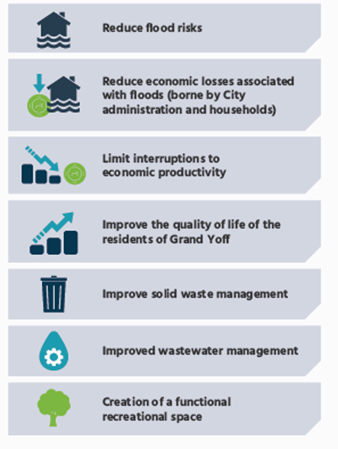
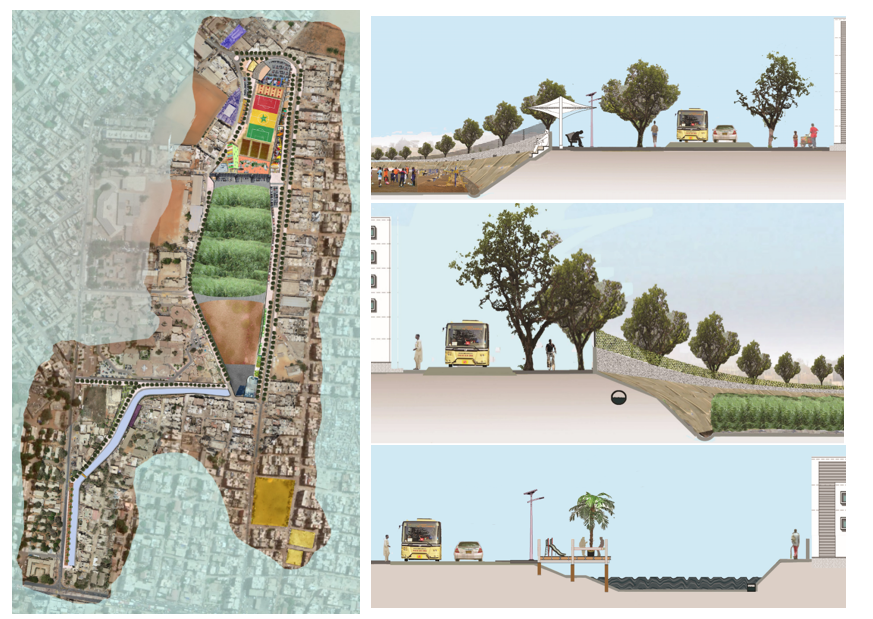
3. Lessons Learned
A key lesson has been the importance of bringing together all relevant stakeholders, ensuring all the actors working on the project have the same level of information. The CCF provided capacity building training about sanitation, urban projects, project management to the city staff and stakeholder. This approach has enabled support for the development of technical studies leading to the preparation of the project for improving the retention basin.
Another important lesson has been involvement of the National Sanitation Office of Senegal (ONAS) from the start of the project. ONAS is in charge of maintenance and operation of the retention basin and the pumping station. Their involvement has been a major asset in moving towards implementation.
The next steps are to carry out environmental and social impact assessments, and to identify various partners from development as private sectors which can support financing of the project.
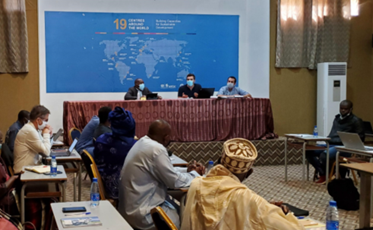
What are the drivers for action?
| Extreme Events | Declining water quality | Water availability |
| ☒Public health hazards
|
☐ High operating costs
|
☐ Water supply disruption
|
| ☒ Damage to infrastructure | ☐ Loss of credibility and trust | ☐ Constraints to growth
|
| ☒ Economic activities and supply chain disruption | ☒ Environmental, cultural and health impacts | ☒ Declining quality of life |
For more information on the Drivers for Action visit the Action Agenda for Basin-Connected Cities.
Pathways for Action
| Assessment | Planning | Implementation |
| ☐Investment in data & information systems
|
☒ Risk-based approach to planning
|
☒ Integration of natural infrastructure
|
| ☐ Linking traditional water management with science
|
☐ Water allocation mechanisms
|
☒ Economic and financing mechanisms
|
| ☐ Invest in values to motivate water decision-making | ☒ Stakeholder participation in planning and management | ☐ Building partnerships from catchment to tap |
| ☐ Aligning urban development with basin management
|
☐ Digital Technologies
|
For more information on the Pathways for Action visit the Action Agenda for Basin-Connected Cities.
4. Useful links and resources
https://c40cff.org/projects/dakar-improving-resilience-to-climate-induced-floodinghttps://www.gret.org/2021/04/designing-and-co-constructing-a-shared-flood-area-at-the-heart-of-dakar/?lang=en
About C40-CFF
The Cities Finance Facility (CFF) is a collaboration of the C40 Cities Climate Leadership Group and Deutsche Gesellschaft für Internationale Zusammenarbeit (GIZ) GmbH. The CFF supports cities in developing and emerging economies to develop finance-ready projects to reduce emissions in support of limiting global temperature rise to 1.5°C and strengthening resilience for the impacts of a warming climate. The CFF is funded by the German Federal Ministry for Economic Development and Cooperation (BMZ), the UK Department for Business, Energy and Industrial Strategy (BEIS), the Children’s Investment Fund Foundation (CIFF) and the United States Agency for International Development (USAID).
